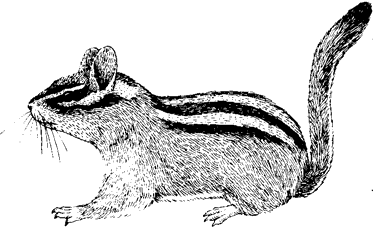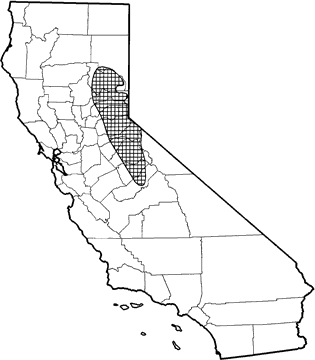
Long-eared Chipmunk
Distribution, Abundance, and Seasonality
Abundant and widespread in mixed chaparral, ponderosa pine, and mixed conifer habitats of the northern Sierra Nevada from Plumas Co. south to Madera Co. Generally found in low- to mid-elevation forests and shrub areas from 1125-2280 m (3600-7300 ft) (Burt and Grossenheider 1976).

Range Map
Specific Habitat Requirements
Feeding: Feeds mainly on fungi, seeds, berries and other fruits, conifer cones, and insects. Searches on the ground, in shrubs, logs, stumps, snags, and trees. Stores food in underground caches for winter use. Fungi are an important summer food, and are the most important summer and autumn food in years of cone crop failure (Tevis 1952, 1953, 1955). Individuals feeding on fungi in a year of cone crop failure were fatter than those that did not have access to fungi. Insects, such as termites or caterpillars of the California tortoise shell butterfly, are an important food source during periods of outbreaks. Long-eared chipmunks sometimes use the feeding stations of tree squirrels (Holdenreid 1940).
Cover: Prefers moderate and low canopy-coverage where shrubs and forbs are available for feeding.
Reproduction: Nests in trees, logs, stumps, in snags, and in burrows.
Water: No data found.
Pattern: Usually associated with patches of brush in forests with sparse to moderate canopy. Creation of edges may be beneficial to this species.
Species Life History
Activity Patterns: Diurnal. Hibernates from the end of October or November until March. Stores some fat for use during dormancy (Tevis 1955), but uses food from underground caches as principal energy source. Occasional arousals separate periods of dormancy. May be active at any time if conditions are mild. Inactivity often begins with the first winter storms (Tevis 1955). Males tend to emerge from hibernation earlier than females (Tevis 1955). Individuals molt into bright summer pelage after reproduction, then molt into winter pelage in autumn.
Seasonal Movements / Migration: None.
Home Range: Home ranges in Madera Co. varied from 0.3 to 2.0 ha (0.8 to 4.6 ac), with averages of 0.5 ha (1.2 ac) for females and 0.9 ha (2.2 ac) for males (Storer et al. 1944). Maximum movements in Plumas Co. were 456 ft (142.5 m) for females, 700 ft (218.8 m) for males (Holdenreid 1940).
Territory: Solitary and probably territorial in the vicinity of the nest. Storer et al. (1944) saw much fighting by males but little evidence for exclusive territories. Male territories appeared to overlap to a greater extent than females.
Reproduction: Breeds from April to mid-July. Gestation lasts 31 days (Ross 1930). The single yearly litter averages 4 (range 3-8). Mating takes place in April and early May; the young are born in June. Lactation takes place predominantly in June, but has been reported to occur in August. The young emerge in July and August. Information on reproduction from Holdenreid (1940), Storer et al. (1944), and Tevis (1955).
Niche: This diurnal, small omnivore is sympatric with T. senex and T. speciosus, although both species tend to be found at higher elevations along the west slope of the Sierra Nevada. Predators include weasels, raptors, coyotes, foxes, and bobcats.
Sources & References
California Department of Fish and Game, 1999.
California's Wildlife, Sacramento, CA.
Written by: J. Harris, reviewed by: H. Shellhammer, edited by: R. Duke
Brand, L. R. 1976. The Vocal Repertoire of Chipmunks (Genus Eutamias) in California. Anim. Behav. 24:319-335.
Burt, W. H., and R. P. Grossenheider. 1976. A Field Guide to the Mammals. 3d ed. Houghton Mifflin Co, Boston, MA. 289pp. Cade, T. J. 1963. Observations on torpidity in captive chipmunks of the genus Eutamias. Ecology. 44:255-261. Grinnell, J., and T. I. Storer. 1924. Animal Life in the Yosemite. Univ. California Press, Berkeley. 752pp. Holdenried, R. 1940. A population study of the long-eared chipmunk (Eutamias quadrimaculatus) in the central Sierra Nevada. J. Mammal. 21:405-411. Ingles, L. G. 1965. Mammals of the Pacific States. Stanford Univ. Press, Stanford, CA. 506pp. Jameson, E. W., Jr., and R. A. Mead. 1964. Seasonal changes in body fat, water, and basic weight in Citellus lateralis, and E. amoenus. J. Mammal. 45:359-365. Johnson, D. H. 1943. Systematic Review of the Chipmunks (genus Eutamias) of California. Univ. Calif. Publ. Zool. 48:63-143. Ross, R. C. 1930. California Sciuridae in captivity. J. Mammal. 11:76-78. Storer, T. I., F. C. Evans, and F. G. Palmer. 1944. Some rodent populations in the Sierra Nevada of California. Ecol. Monogr. 14:166-192. Storer, T. I., and R. L. Usinger. 1963. Sierra Nevada natural history. Univ. California Press, Berkeley. 374pp. Sutton, D. A., and C. Dunford. 1974. Bibliography of the chipmunk, genus Eutamias, in North America. Calif. State Univ., Chico. 26pp. Tevis, L., Jr. 1952. Autumn foods of chipmunks and golden-mantled ground squirrels in northern Sierra Nevada. J. Mammal. 33:198-205. Tevis, L., Jr. 1953. Stomach contents of chipmunks and mantled squirrels in northeastern California. J. Mammal. 34:316-324. Tevis, L., Jr. 1955. Observations on chipmunks and mantled squirrels in northeastern California. Am. Midl. Nat. 53:71-78.
California Animal Facts | California's Wildlife